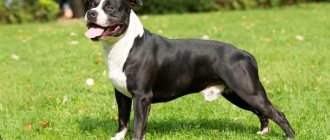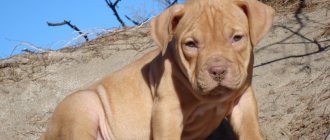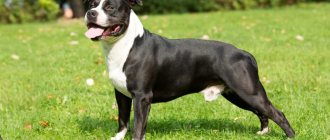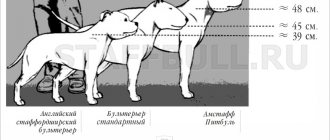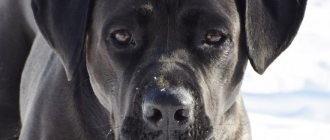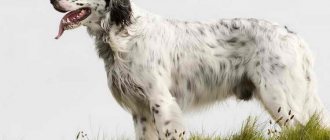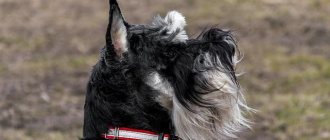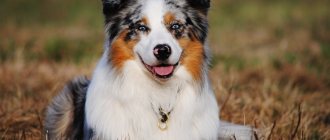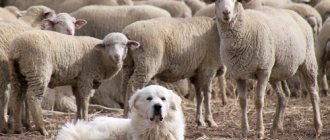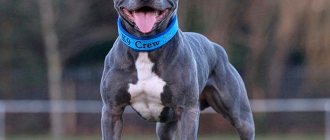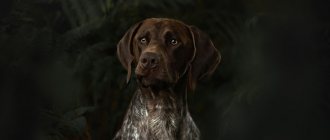Origin history and interesting facts about the Staffordshire Terrier
The staff dog has medieval roots. Until the beginning of 1800, it was customary to hold gladiator fights in England to attract the attention of the crowd. Both people and animals entered the arena. Over time, human participation in fighting ended, and the crowd began to entertain the crowd with dog fights. At first they were used to set bulls against each other, then monkeys, lions, bears and tigers.
Staffordshire Terriers are often hired for service in the Ministry of Emergency Situations
For your information! One of the fans of such spectacles was the Earl of Stamford. At his direction, battles began to take place more frequently. Such massacres served as reasons for the development of fighting breeds. Two types of dogs were often used: mastiffs and bulldogs. The most nimble and agile animals were selected for battle.
Since 1835, fights involving bulls have been banned. However, dog-dog fights continued. At the same time, breeds appeared that became the progenitors of the Amstaff - a combination of a bulldog and a fox terrier. As a result of the crossing, a Bull and Terrier dog was obtained, which had optimal weight, strength and endurance. After some time, these dogs began to be called pit bull terriers.
In 1870, the first representatives came to the United States, where they continued to participate in battles. Some breeders began to notice that not all representatives showed aggression; some dogs were quite friendly. Breeders decided to select the most peaceful dogs in order to improve the breed and make helpers and companions. The work was carried out for a long time, and in 1936 the Staffordshire Terrier breed was officially recognized.
From English terriers, Staffordshire terriers inherited the ability to catch rats.
For your information! On the Internet you can find other names for the breed - Stafashire Terrier and Staforshi Terrier, but this is just an erroneous spelling. According to the standard, the variety is registered only as the Staffordshire Terrier.
Description of the breed
The Staff is a strong, muscular, stocky dog with a harmoniously built body. The first impression is aggressiveness and power. But in fact, the dog is inquisitive, sociable and kind. Let's look at his body parameters:
| Appearance | Characteristics |
| Head | slightly elongated, square in shape, medium in size. The cranial vault is quite wide, flat between the ears. There is a small bump on the occipital area. The forehead is distinguished by its convexity, a pronounced transition from the line of the forehead to the muzzle. The parietal muscles are dense; |
| Teeth | strong, white, large. The jaw is powerful, with a scissor bite. The incisors are distinguished by their linear arrangement; |
| Eyes | round, black (or dark) shade, set wide. Eyelids – pigmented and dry, dark. A piercing and attentive gaze; |
| Nose | round, black, with large, open nostrils. The lips tightly hide the jaw below, densely pigmented; |
| Ears | set high, straight. They must be docked, they are sharp. If they are not docked, then they are short, erect on the cartilage; |
| Neck | dense, wide, massive, medium length. The nape line is clearly visible and even. Muscularity is pronounced, there is a slight widening at the withers. There are no folds of skin, as well as saggy areas |
| Frame | convex ribs, powerful chest, set wide apart. Short but massive back, toned, muscular stomach; |
| Tail | short, smooth, tapering at the end. No need to buy. In an excited, active state, the tail is constantly in a horizontal position; |
| Limbs | The front legs are clearly muscled, straight, and have strong bones. The shoulder joint is oblique, the elbow is pressed to the body, the metacarpus are slightly deviated. The hind legs are well defined at the joints, level and straight. The paws themselves are round, strong, and medium in size. |
The staff's movements are confident, smooth, and springy. The coat is hard to the touch, shiny, and thick. There is no undercoat; it adheres tightly to the skin. The color can be anything except white - this is a breed defect that cannot be bred. The general acceptable percentage of white stains is no more than 25 - 20% of the entire surface.
The dog is easygoing, obedient, it is not difficult to train, the main thing is to do this from an early age.
Requirements for the Staffordshire Terrier breed standard
Yak Terrier (German Jagdterrier): characteristics of the breed
American staff must meet the following standard:
- medium sized head;
- the muzzle is quite muscular, wide with a pronounced transition on the forehead;
- high-set ears, if cropped, should stand up;
- eyes are deep dark brown;
- the jaws are large and powerful;
- nose is black;
- paws of medium length, muscular, front legs set wide apart;
- the neck is large, straight;
- the stomach is tucked;
- the back is straight and wide;
- the tail is short, tapering to the tip, set low.
Note! The Staffordshire Terrier is usually fast moving and active. The gait should be slightly springy.
Staffordshire Terrier height and weight chart
The table shows the optimal height and weight indicators depending on the age of the Staffordshire Terrier:
| Age, in months | Weight, kg | Height, cm |
| 1-2 | 2,3-9 | up to 31 |
| 3-4 | 9,5-18 | 30-45 |
| 5-6 | 17,5-27 | 36-50 |
| 9 | 25-32 | 40-50 |
| 12 | 25-34 | 42-50 |
| 18 | 25-39 | 44-50 |
Staffordshire Terrier colors
Staff black is considered the most common color. Almost all solid colors are also allowed: from black to cream. If the wool is two-color, then according to the standard there should be no more than 20% spots.
Note! The purebred American Staffordshire Terrier is brindle.
Brindle dogs have dark stripes on their bodies.
Types of Staffordshire Terriers
Description of the Staffordshire Terrier breed includes the division of dogs into three types:
- Staff proportional. According to external data, it is closest to the standard. Such animals have a wide turn of the shoulders, a voluminous chest and a correctly proportioned body. The dogs are active and mobile;
- The American Staffordshire Terrier of the bulldog type is distinguished by its large weight (more than 46 kg). These representatives have rough body features and a short neck. Due to the inverted elbows, the animals have slightly constrained movements;
- A terrier-like Stafic, often considered a dwarf species. Weighs up to 28 kg. They are distinguished by an elongated and narrow mouth. The neck is long without a pronounced turn.
Character and habits
The American Staffordshire Terrier with a healthy psyche is always friendly towards people and tolerant of other animals. If you want to get an Amstaff, it is recommended to forget about its fighting past and raise the puppy as a house dog. Staffordshire Terriers are stubborn and independent like bulldogs, agile and active like terriers. This dog is distinguished by perseverance, willpower and courage. Amstaffs are loyal to the owner and his family, and can be excellent companion dogs, bodyguards, watchdogs, and sports dogs. They require training from a very early age, and all family members must participate in the dog's training process. These dogs can show aggression towards their relatives. It is not recommended for Amstaff dogs to be trained as guard and fighting dogs; with inadequate training and subsequent mistakes by the owner, this can have the most disastrous consequences for both the dog and the people and animals around them.
Attitude towards children and others
American Hairless Terrier (English Hairless Toy)
With proper training, the Staffordshire Terrier grows up to be a socialized and sociable dog. Pets adore their owner and are always ready to be near. Dogs sense when they need to help. Balanced staffers do not pose a danger to their surroundings.
Important! In families with children, they get along well with kids. However, you should not leave a small child with a dog, as the pet may accidentally harm the baby while playing.
Origin of the breed
The breed was developed by crossing a bulldog and an English terrier, which were brought to America in 1870. The name was changed several times: Belterrier, Pit - Great Dane, Pit - Bull Terrier. For quite a long time the animal was not accepted in the canine community, but was actively used in dog fighting. The Staffordshire Terrier was bred in 1930, the standard and classification were approved in the same period. The dog was bred for home use. The year 1970 was decisive: the dog was given its name, which we are accustomed to now - “American Staffordshire Terrier”.
Security and guard qualities
The Staffordshire Terrier has good watchdog and security traits. Dogs are able to discern a person’s mood, so in case of danger they will immediately begin to protect their owner. Pets have quite strong nerves, so it will take a lot of time to get them angry. However, if the staff senses danger, then anger can come in an instant, then the dog will fight to the end.
For your information! Strength and endurance allow dogs to guard large territories and cope with several enemies at once.
In addition to their guard qualities, staffs often become participants in rescue operations. They are good at tracking and also help rescue people from emergency situations.
Training and education of the Staffordshire Terrier
The Stafford is a dog that needs to be trained from childhood. When a puppy appears in the house, the owner must understand that he is taking on a serious responsibility. The first thing babies are taught is to sleep in their place and respond to their name.
After all vaccinations have been completed, the puppy can go outside. This is also an important point, since proper socialization affects the future character of the baby. No matter how much the owners love their pet, they cannot forgive and allow everything. Bad behavior must be punished.
Note! It is necessary to reprimand your pet at the moment when the trouble occurs, and not after a while. Any physical influence is strictly prohibited.
Experts recommend raising dogs with a stern voice, without shouting or swearing. Another method is ignoring. It is used in cases where the staff does a dirty trick on purpose. It is important here that ignoring comes from all family members, otherwise the dog will easily find a protector and will not understand the punishment.
Training should include regular sessions, during which the person clearly explains to the dog what needs to be done.
Be sure to reward the animal with a treat or stroking
Care and hygiene
The Staff dog breed is suitable for keeping both in a private house and in small apartments. However, you should not keep your pet in a booth or enclosure. The staff terrier has a very thin coat, so it is difficult to tolerate frost. For the cold season, it is recommended to purchase insulated clothing (sweaters, overalls).
It is necessary to bathe your pet 1-2 times every 2 months or after heavy soiling. Special shampoos are used for washing. After heavy exercise, you should wipe the Staffordshire Terrier's coat with a damp towel. Check the skin regularly for wounds and abrasions. On average, nails are trimmed 1-2 times a month. Inspect the ears regularly and clean them with a cotton pad soaked in water.
Starting from 6 months, the necessary vaccinations are given annually. Whether or not to crop ears is a personal matter for the owners and does not require mandatory execution.
Note! To give wool a shiny look, many owners use car suede. It is necessary to treat the dog's coat after bathing.
Staffordshire Terrier diet
The Amstaff (breed characteristics are listed above) should eat according to the diet. Food is poured 2 times a day at the same time. Be sure to provide your dog with constant access to clean water. The diet should be balanced and consist of different foods.
Required set:
- raw meat;
- offal;
- cereals;
- vegetables;
- milk products.
Important! If owners choose ready-made food for their pet, then they should pay attention to premium and super-premium food. They contain all the necessary microelements and vitamins.
Prohibited products: sweets, sausages, pickled vegetables, food with seasoning.
Walk
The Staffordshire Terrier is a very active breed that needs regular walks and exercise. For normal development, you need to spend about 3 hours walking every day. In summer, you can add swimming in a pond to your regular walk.
Note! When walking in places where other animals and people gather, it is necessary to put a muzzle on the staff.
Compared to the German Shepherd, the Staff is much more active
American Staffordshire Terrier breed standard N 286 according to FCI. Approved May 26, 1971
General form.
The American Staffordshire Terrier should give the impression of being a dog of great strength for its size, well built, muscular, but at the same time elegant, agile and very responsive to its surroundings. The American Staffordshire Terrier should be stocky in appearance, not long-legged or greyhound-like. His courage is legendary.
Head.
Medium length, deep, wide, with clearly defined muscles and a distinct transition from forehead to muzzle.
Ears
- set high, cropped or undocked.
The latter are preferred. Uncropped ears should be short and carried semi-erect or erect. Completely drooping ears are rejected. The eyes
are dark, round, deep-set and widely spaced.
Pink eyelids are not acceptable. The muzzle
is of medium length, with a sharp transition to the skull, not lowered.
The bridge of the nose is rounded. The jaws
are clearly defined.
A strong lower jaw provides a powerful grip. Lips
- dense, close-fitting, not drooping.
The upper incisors meet the front of the lower incisors. The nose
is always black.
Neck.
Massive, slightly curved, tapering from the shoulders to the back of the head, medium length, without dewlap.
Shoulders.
Strong and muscular, with wide, obliquely set shoulder blades.
Top line.
Quite short, with a slight slope from the withers to the croup and a smooth short slope of the croup to the base of the tail. The stomach is slightly tucked.
Frame.
The chest is wide and deep throughout, with fairly convex, tightly packed ribs. The forelimbs are widely spaced, which results in a well-developed chest.
Tail.
Short compared to the size of the dog. Low set, tapering towards the end. Not hooked, not thrown over the back. Undocked.
Limbs.
The front ones are straight, with powerful rounded bones. Pasterns are vertical. The hind limbs are very muscular. Hocks moderately short. The hocks are turned neither in nor out. The paws are of medium size, well arched and well-knit. The movements are springy. Ambling is a vice.
Wool.
Short, close-fitting, hard to the touch and shiny.
Color.
Any color is allowed - single-color, particolor, spotted. Pure white color or white color exceeding 80% of the body surface, as well as black and tan or liver are undesirable.
Height and weight.
Definitely proportional. Height at the withers is about 18-19 inches (46-48 cm) for males and 17-18 inches (44-46 cm) for females.
Flaws.
A fleshy or light brown nose, light eyes or pink eyelids, a tail that is too long or worn incorrectly, undershot or undershot.
The UKC standard (as amended on January 1, 1978) differs only in the points regarding the permitted color of the nose, eyes and coat; it allows any color. The remaining requirements coincide with the requirements of the AKS.
Anatomy - physiological characteristics of the American Staffordshire Terrier.
- Head. Large, beautiful, massive.
- Ear. Docked and undocked options are allowed. Cropped ears are erect, clearly defined, and the crop line is straight. Uncropped ones have the shape of a “flower”, from the head the auricle goes vertically upward, 1/2 or 1/3 from the tip there is a smooth bend downwards.
- The eyes are round, looking forward, the whites are visible only in the extreme leads, the color of the eyes is darker than the color. Subject vision up to 500-700 meters.
- The transition from forehead to muzzle is pronounced.
- The bridge of the nose is straight, of medium length, hooked and snub noses are undesirable. The nostrils are wide, breathing is free. Great instinct.
- The nose is dark, well pigmented, liver color is rejected.
- The jaws are very powerful, widening towards the molars, the angles of the lower jaw (cheekbones) are pronounced and widen somewhat to the sides, more sharply in males.
- The teeth should have a full set of incisors, premolars and molars. Scissor bite.
- The lips are pigmented, selected, medium-sized. The corners of the lips are slightly parted.
- The scruff smoothly passes from the head to the neck.
- The neck is medium, mobile, muscular, short and sagging is undesirable.
- The shoulder blade is large, wide, adjacent, its muscles are developed.
- Shoulder with a developed shoulder joint, range of motion about 120°
- The elbow is rounded, not sticking out to the side and not turned inward, movement is approx. 80°
- The forearm has powerful ulna and radius bones, straight, when viewed from the front there is no convergence or divergence of the paws.
- The wrist at a slight angle to the forearm, (the so-called carpal protrusion), a straight joint leads to excessive load on the wrist joint when jumping and on solid ground, a “slack” joint - the metacarpus sags towards the ground - indicates a weak ligamentous apparatus.
- The pastern is dry, springy, capable of withstanding heavy loads.
- There are 5 toes on the front paw, 4 on the hind paw, dewclaws indicate errors in breeding. The fingers are in a “lump” and diverge only on very loose soils. The fur between the toes is short and snowballs do not form on the paws in winter.
- The claws are strong and therefore prone to growing and sometimes require trimming.
- The chest is round, very voluminous, the ribs are powerful, mobile, the sternum does not protrude.
- The belly is lean, smoothly transitions from the ends of the ribs to the groin.
- Groin. A male dog's testicles descend into the scrotum no later than 2-3 months of age.
- Tail. Straight, slightly drooping, tapering smoothly towards the tip. Not rounded at the top. Reaches to the hock joint.
- Thigh with very pronounced muscles, movements in the hip joint over 130°.
- The hock joint is powerful, with dense connective tissue, ideally not completely straightened (angle), which contributes to the optimal take-off push during movement due to the springy properties of the joint.
- The metatarsus is dense, dry, not “tucked in” or “set back.”
- The paw pads are dense, not excessively keratinized, and springy.
- Visible mucous membranes are clean, deep pink. Pale mucous membranes may indicate congestion or poor nutrition (lack of minerals, in particular iron. The tongue is clean, not coated.
- Skin of dense elastic consistency, smooth, mobile; folds and “suspension” on the neck are undesirable
- The coat is shiny, thick, short, lies tightly, there is no undercoat, black and tan and pure white colors are undesirable.
- Body temperature in the AST rectum ranges from 38°C to 39.5°C.
- The number of respirations at rest varies from 35 per minute in puppies to 12 in adult dogs. Under load (running, heat) it can increase to 60-70 per minute. The volume of the lungs of a male is about 3 liters, of a female - 2.5 liters;
- Resting heart rate ranges from 200 beats per minute in newborn puppies to 60 in adult dogs. The time it takes for the heart rate to return to normal after exercise is up to 1.5 minutes and is considered satisfactory.
- Bitches come into heat after 6-10 months, starting at about 9-12 months of age, lasting about 20 days. Mating is favorable on days 9-13 of estrus. AST are late maturing dogs. It is strictly not recommended to breed a female before 20 months of age. Pregnancy lasts from 57 to 65 days, the number of puppies in the litter varies from 4 to 15. Bitches almost always give birth without complications for themselves and their offspring, are capable of nursing, and lactation is usually abundant.
- A male dog is capable of conceiving from 7-8 months of age, but for similar reasons it is not worth breeding a male dog before the age of one and a half years.
- The gastrointestinal tract as well as the liver and pancreas of the AST, compared to other breeds, is resistant to a variety of foods, but still, according to our observations, the best results are obtained by the use of professional dry food
- The kidneys are large, the excretory system of AST is practically not susceptible to diseases (urolithiasis, nephritis, prostatitis)
Lifespan of a Staffordshire Terrier
The Staff Terrier is generally distinguished by good health and immunity. Most often, diseases affect older representatives. Common pathologies include:
- hip dysplasia;
- deafness;
- heart disease;
- retinal atrophy;
- entropion of the eyelid;
- cataract.
With proper care, pets can live 11-15 years
Disease susceptibility
Amstaffs are predisposed to dysplasia of the elbow, hip joints, and spondyloarthrosis. They may experience allergic dermatitis, atopy, pododermatitis, and skin mastocytoma.
Also, dogs of this breed may be prone to hyperplasia of the soft palate, entropion of the eyelids and chronic conjunctivitis. Adult dogs can develop obesity, kidney failure, and sometimes heart disease, such as arrhythmia cardiomyopathy.
Proper care of the American Staffordshire Terrier and regular veterinary examinations will help to avoid the development of many diseases in the dog and improve the animal’s quality of life, especially in older age.
